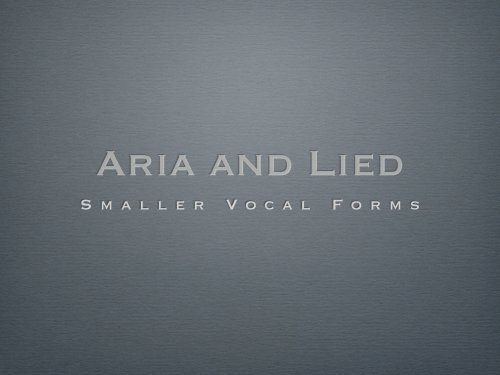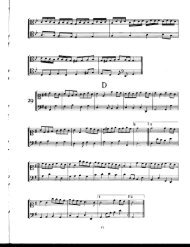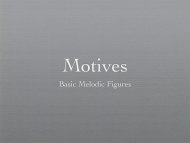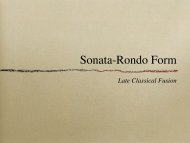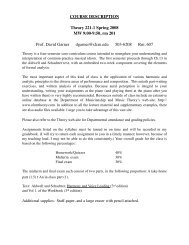Aria and Lied - SFCM Theory
Aria and Lied - SFCM Theory
Aria and Lied - SFCM Theory
Create successful ePaper yourself
Turn your PDF publications into a flip-book with our unique Google optimized e-Paper software.
<strong>Aria</strong> <strong>and</strong> <strong>Lied</strong><br />
S m a l l e r V o c a l F o r m s
Stile recitativo<br />
Recitativo secco (parl<strong>and</strong>o)<br />
Recitativo accompagnato<br />
Recitative
Stile recitativo<br />
Earliest form of recitative, from early opera<br />
Chords specified by basso continuo<br />
The voice’s recitation is free to imitate the rhythms of<br />
speech.<br />
Example: Jacopo Peri, l’Euridice: “Per quel vago<br />
boschetto”
Recitativo secco<br />
Also known as recitativo parl<strong>and</strong>o<br />
“Dry”: accompanied by sustained or staccato chords<br />
interpolated at the rests in the vocal line. (Chords are<br />
indicated by figures, not notes.)<br />
Form is free, the text being often in prose rather than<br />
poetry.<br />
Typical of opera seria, carries the brunt of the plot.
Recitativo secco<br />
Can make a useful laboratory for studying simple<br />
harmonic motions, in particular applied dominants <strong>and</strong><br />
seventh chords, which tend to abound.<br />
The recitatives tend to be ignored by analysts, but they<br />
can be fruitful topics for study.
!"#$%&'(!"#$"%&'()*+()(*+,-(#./-&%($.#0%&&"(12-%$%*<br />
(<br />
(<br />
(<br />
!" " " "<br />
!" " " "<br />
!" " " "<br />
#<br />
!<br />
!<br />
!<br />
$ $<br />
" #<br />
$<br />
$<br />
#<br />
&%<br />
%&!!<br />
% &$<br />
%<br />
" $<br />
$<br />
#<br />
%<br />
%<br />
'<br />
'<br />
$ &$<br />
%<br />
" (<br />
3(((((4<br />
)<br />
$<br />
$<br />
%*<br />
&%<br />
%&!<br />
$ $ & $<br />
& $ $ &$<br />
%$ #<br />
'<br />
" (<br />
" $ 3(((((4 %<br />
$<br />
#<br />
%&!!<br />
&$<br />
&$<br />
$<br />
#<br />
" $ 3(((((((4 ( &$ %<br />
%<br />
'<br />
$<br />
'<br />
" $<br />
$<br />
#<br />
%<br />
!<br />
$<br />
!<br />
" $ %<br />
$<br />
#<br />
')<br />
$<br />
')<br />
$<br />
$<br />
( %<br />
+<br />
')<br />
$ % $ $<br />
'<br />
" (<br />
3(((((4<br />
))<br />
$<br />
))<br />
$<br />
( %<br />
+<br />
))<br />
$ $<br />
$<br />
+<br />
,+"*&-(."/)<br />
$<br />
( #<br />
$ (<br />
&<br />
$<br />
!<br />
%<br />
!<br />
%<br />
!
Recitativo<br />
Accompagnato<br />
First Style: adds longer, sustained chords in the<br />
accompaniment while the vocal line continues similarly to<br />
the secco style.<br />
Christ’s arias in the St. Matthew Passion are in this style, in<br />
which a “halo” of string chords around Jesus appear for<br />
his recitative.
Recitativo<br />
Accompagnato<br />
St. Matthew Passion: Da das Jesus merkete...<br />
The Evangelist begins with a st<strong>and</strong>ard secco recitative,<br />
<strong>and</strong> then the string “halo” appears when Jesus begins<br />
singing.
Recitativo<br />
Accompagnato<br />
In the St. Matthew Passion, the “halo” around Jesus’s<br />
recitatives disappears once -- at the words “Eli, eli, lama<br />
sabachthani” (“My God, My God, why have you<br />
forsaken me?”)
Recitativo<br />
Accompagnato<br />
Second Style: much more metrical, with a patterned<br />
accompaniment. The vocal line is also metrical.<br />
More commonly found in oratorios <strong>and</strong> passions.<br />
An example from the St. Matthew Passion: “Wiewohl mein<br />
Herz”
Later Recitative<br />
It did not really die out in the 19th century, although the<br />
clear classifications of earlier opera began to blur.
Wagner Recitative<br />
Die Walkure, from Act I: this is a distinct recitativo secco.
Wagner Recitative<br />
A typical Wagnerian accompagnato, in which the orchestra<br />
provides leitmotifs as well as other materials, while the<br />
vocal line sails either above or through the instrumental<br />
texture.
Arioso<br />
Halfway between recitative <strong>and</strong> aria<br />
More melodic than recitative<br />
Less extended than aria<br />
Often the concluding section of a lengthy recitative.
Arioso<br />
Bach was in particular fond of arioso in the cantatas <strong>and</strong><br />
oratorios.<br />
Cantata No. 83 Ich habe genug, in the second recitative, at<br />
the words “Welt! gute Nacht.”
Strophic <strong>Aria</strong><br />
Typically 17th century, early <strong>and</strong> mid Baroque practice.<br />
Two-part song form as a rule, with the second strophe<br />
varied a bit to accomodate the text.
Strophic <strong>Aria</strong><br />
Cesti: Orontea: Act II, Scene 17 Intorno all’idol mio<br />
Two-part song form with 2 strophes<br />
In each strophe, Part II of the song form is repeated as a<br />
cadential passage.
Strophic <strong>Aria</strong><br />
Several other types are also possible:<br />
A B B’<br />
Typically ABB’ - Ritornello - ABB’ - Ritornello<br />
A B A’<br />
Typically ABA - Ritornello - ABA - Ritornello<br />
The source of the da capo aria.
Da Capo <strong>Aria</strong><br />
The st<strong>and</strong>ardized form is:<br />
1. Two poetic stanzas of approximately equal length <strong>and</strong><br />
similar rhyme scheme.<br />
2.Each stanza normally ends with a cadential verso trunco<br />
(with the accent on the final syllable)
Da Capo<br />
Example for study: V’adoro, pupille from H<strong>and</strong>el’s Giulio<br />
Cesare.
Da Capo <strong>Aria</strong>: Text<br />
Tetrameter: four beats to a line<br />
Dactylic: composed of dactyls (long short short)<br />
Fourth-syllable rhymes: a b a b<br />
First-syllable rhymes: x y x y<br />
Second-syllable rhymes: s s t t<br />
Stanza 1<br />
Stanza 2<br />
V’adoro, pupille, saette d’amore<br />
le vostre faville so grate nel sen<br />
Pietose vi brama il meso mio core<br />
ch’ogn’ora vi chiama l’amato suo ben<br />
I adore you, eyes, Cupid’s darts | Your sparks are welcome in my breast.<br />
My sad heart craves your mercy | forever calling you its dearest love.
da Capo<br />
Da Capo <strong>Aria</strong><br />
A<br />
Stanza 1<br />
A’<br />
Stanza 1 repeated with variance<br />
B<br />
Stanza 2<br />
A<br />
Stanza 1<br />
A’<br />
Stanza 1 repeated with variance<br />
a<br />
b<br />
a’<br />
b’<br />
c<br />
d<br />
a<br />
b<br />
a’<br />
b’
First Stanza<br />
A<br />
Stanza 1<br />
Opening Ritornello<br />
Usually self-contained with a full close in the tonic<br />
Moves harmonically from I to the st<strong>and</strong>ard secondary key (typically V)<br />
a<br />
b<br />
HC<br />
PAC
First Stanza Repeat<br />
A<br />
Stanza 1<br />
Second Ritornello<br />
Shorter, in the secondary key<br />
May begin in an entirely new key<br />
Eventually moves back to the tonic<br />
Sometimes may act developmentally<br />
a<br />
b<br />
PAC
Third Ritornello<br />
Third Ritornello<br />
In the tonic key<br />
Brings the section to a close<br />
Will close the entire aria after the da Capo
Second Stanza<br />
B<br />
Stanza 2<br />
Often in a contrasting key or style<br />
Generally stated only once, with or without internal repetitions<br />
Can be dramatically different in key, tempo, <strong>and</strong> meter<br />
Often ends in the minor or with a Phrygian cadence, preparing for the da Capo<br />
c<br />
d<br />
PAC
da Capo<br />
A<br />
Stanza 1<br />
A’<br />
Stanza 1 repeated with variance<br />
Da Capo<br />
Opening Ritornello<br />
May be omitted, or shortened<br />
Typically ornamented<br />
Sections may be improvised, as long as they keep to the basic form<br />
Cadenzas can occur, typically before the final b’ statement.<br />
a<br />
b<br />
a’<br />
b’
Final Ritornello<br />
Final Ritornello<br />
In the tonic key<br />
Brings the entire aria to a close
H<strong>and</strong>el<br />
“V’adoro, pupille” from Giulio Cesare<br />
Renée Fleming <strong>and</strong> the Orchestra of the 18th Century
Dal Segno <strong>Aria</strong><br />
In a dal segno aria, the return is not back to the very<br />
beginning, as in the da capo, but somewhere later, as a<br />
technique to shorten the return of A.<br />
Typically the return was at the second solo (A’) rather<br />
than the first.<br />
If the second solo was in the secondary key, composers<br />
might write out the first solo <strong>and</strong> then mark the segno at<br />
A’ where the tonic return occurs.<br />
Or they might provide a version of A’, adjusted to stay in<br />
the original tonic key.
Dal Segno <strong>Aria</strong><br />
Bach: “Mein Jesu, ziehe mich nach dir” (BWV 22)<br />
The return to the tonic key for A’ gives this aria a distinct<br />
sonata-form character.
A (Exposition)<br />
R<br />
1<br />
c minor<br />
1(P)<br />
13<br />
c minor<br />
Rf<br />
15<br />
B (Development)<br />
A’ (Recapitulation)<br />
1<br />
2<br />
3<br />
4<br />
5<br />
6<br />
4<br />
36<br />
g minor<br />
Rf<br />
49<br />
c minor<br />
1(P)<br />
53<br />
c minor<br />
R<br />
73<br />
c minor<br />
5<br />
40<br />
f minor<br />
Rf<br />
55<br />
6<br />
42<br />
1(P)<br />
18<br />
1(P)<br />
58<br />
Rf<br />
44<br />
Ab Maj<br />
2 (1S)<br />
22<br />
Eb Maj<br />
6 (part)<br />
45<br />
c min HC<br />
2 (1S)<br />
62<br />
c minor<br />
Mein Jesu, mich nach dir<br />
Ich bin bereit, ich will von hier<br />
Und nach Jerusalem zu deinem Leiden gehn<br />
Wohl mir, wenn ich die Wichtigkeit<br />
Von dieser Leid- und Sterbenzeit<br />
Zu meinem Troste kann durchgehens wohl verstehen!<br />
3 (2S)<br />
26<br />
Rf (retr)<br />
48<br />
c minor<br />
3 (2S)<br />
66<br />
3 (2S)<br />
29<br />
Rf<br />
33<br />
Eb Maj<br />
My Jesus, draw me after you<br />
I am ready, I am ready to leave here<br />
And go to Jerusalem to your passion<br />
It is a good thing when I underst<strong>and</strong><br />
The importance of this time of suffering <strong>and</strong><br />
death thoroughly to my comfort!
Three-Part Song<br />
Form<br />
Mozart: “Un auro amoroso”, No. 17 from Così fan tutte<br />
A breath of love from our treasures<br />
will afford our hearts sweet sustenance.<br />
A heart nourished on the hope of love<br />
has no need of greater inducement.
Period 1<br />
Period 2<br />
Part I: Contrasting<br />
Double Period<br />
a<br />
b<br />
c<br />
d<br />
d’<br />
PAC<br />
HC<br />
HC; V ped<br />
IAC<br />
PAC;<br />
quasi-codetta<br />
Un’ aura amorosa del nostro tesoro<br />
un dolce ristoro al corporgerà<br />
Un’ aura amorosa del nostro tesoro<br />
un dolce ristoro al corporgerà<br />
un dolce ristoro al corporgerà
e<br />
f<br />
g<br />
Part II: Phrase<br />
Group<br />
HC in V<br />
IAC in V<br />
Al cor che nudrito da speme d’amore<br />
d’un esca migliore bisogno non ha<br />
extended; PAC in V d’un esca migliore bisogno non ha
Period 1<br />
Period 2<br />
Part III: Contrasting<br />
Double Period<br />
a<br />
b<br />
c<br />
d<br />
d’<br />
PAC<br />
HC<br />
HC; V ped<br />
IAC<br />
PAC;<br />
quasi-codetta<br />
Un’ aura amorosa del nostro tesoro<br />
un dolce ristoro al corporgerà<br />
Un’ aura amorosa del nostro tesoro<br />
un dolce ristoro al corporgerà<br />
un dolce ristoro al corporgerà
Second Rondo<br />
Second Rondo with three stanzas of text:<br />
Gluck: “Che faro senza Euridice?” from Orfeo ed<br />
Euridice.
Ritornello<br />
A<br />
B<br />
A<br />
I<br />
PAC<br />
V<br />
PAC<br />
I<br />
PAC<br />
Transition<br />
C V ped.<br />
HC<br />
Che farò senza Euridice?<br />
Dove <strong>and</strong>rò senza il mio ben?<br />
Che farò? Dove <strong>and</strong>rò?<br />
Che faro senza il mio ben?<br />
Dove <strong>and</strong>rò senza il mio ben?<br />
Euridice! Euridice!<br />
Oh dio! Rispondi! Rispondi!<br />
Io son pure il tuo fedel.<br />
Che farò senza Euridice?<br />
Dove <strong>and</strong>rò senza il mio ben?<br />
Che farò? Dove <strong>and</strong>rò?<br />
Che faro senza il mio ben?<br />
Dove <strong>and</strong>rò senza il mio ben?<br />
Euridice! Euridice!<br />
Ah! Non m’avanza<br />
più soccorso, più speranza,<br />
né dal monto, né dal ciel!<br />
What shall I do without Eurydice?<br />
Where shall I w<strong>and</strong>er,<br />
What shall I do? Where shall I w<strong>and</strong>er?<br />
What shall I do without her?<br />
Where shall I w<strong>and</strong>er without her?<br />
Eurydice! Eurydice!<br />
Oh please answer! Answer!<br />
I am ever faithful to you.<br />
What shall I do without Eurydice?<br />
Where shall I w<strong>and</strong>er,<br />
What shall I do? Where shall I w<strong>and</strong>er?<br />
What shall I do without her?<br />
Where shall I w<strong>and</strong>er without her?<br />
Eurydice! Eurydice!<br />
No hope, or succour,<br />
are now left to me<br />
from mortals or from Gods.<br />
A I<br />
Che farò senza...etc.<br />
What shall I do without...etc.<br />
Ritornello
Operatic Rondò<br />
Extensive operatic aria in two parts:<br />
Slow section<br />
Fast section<br />
Emerged in the 18th century <strong>and</strong> began to replace the da<br />
capo aria during the 1770s.
Operatic Rondò<br />
Slow Fast<br />
Ritornello 1 Solo 1 Ritornello 2 Solo 2 Ritornello 3<br />
I I-V-I I I mod V-I I
Operatic Rondò<br />
Mozart: “Per pieta”, from Così fan tutte<br />
Fiordiligi expresses her torment at being in love with two<br />
different men.<br />
In part 1, Adagio, she expresses remorse for her<br />
unfaithful thoughts <strong>and</strong> pledges to be faithfl to her<br />
fiancé.<br />
In part 2, Allegro moderato, she chastises herself <strong>and</strong><br />
reaffirms her fidelity.
Operatic Rondò<br />
The inner ritornelli in this aria are very short transitions<br />
or links, rather than being complete sections.<br />
They aren’t indicated in the analysis chart, given their<br />
brevity.
Operatic Rondò<br />
In the aria, the middle of the Allegro moderato brings back<br />
the text from the Adagio, a characteristic practice of this<br />
form.
<strong>Lied</strong>: Early<br />
“Bar” Form (AAB) can be traced back to the surviving<br />
ancient Greek music.<br />
Very common in monophonic medieval song<br />
(troubadours, trouvères, Minnesingers, etc.)
Bar Form<br />
The stanzaic form of the song may be somewhat different<br />
from the musical form -- always check both.<br />
Bar form can take a wide variety of sub-forms<br />
In particular, the ‘B’ section can be quite involved, <strong>and</strong><br />
may even feature returns to material from the ‘A’ section.
Bar Form<br />
Most pieces in bar form are strophic, in that the basic<br />
musical setting AAB is used to set a number of poetic<br />
verses.<br />
“Strophic” always refers to multiple stanzas of text which<br />
are set to the same melodic structure.
Bar Form<br />
Bernart de Ventadorn (12th century, 2nd generation<br />
troubadour): La dossa votz<br />
Strophic<br />
Musical form: AAB<br />
Verse form: A B A’ B’ C D B’’ E
A<br />
A<br />
B<br />
!<br />
1<br />
!<br />
2<br />
!<br />
3<br />
!<br />
4<br />
!<br />
5<br />
!<br />
6<br />
!<br />
7<br />
!<br />
8<br />
A<br />
"<br />
La<br />
B<br />
"<br />
del<br />
A'<br />
"<br />
que<br />
B'<br />
"<br />
si<br />
C<br />
"<br />
el<br />
D<br />
"<br />
me<br />
B''<br />
"<br />
et<br />
E<br />
"<br />
au<br />
"<br />
leu<br />
"<br />
dos<br />
"<br />
ros<br />
"<br />
m'es<br />
"<br />
que<br />
"<br />
mal<br />
"<br />
"<br />
- sa votz<br />
"<br />
"<br />
# "<br />
ay<br />
"<br />
au<br />
- si - nho - let sal<br />
"<br />
dins<br />
"<br />
tot<br />
"<br />
"<br />
lo<br />
# "<br />
lo<br />
- tratz c'a<br />
- ja e<br />
"<br />
au<br />
"<br />
"<br />
"<br />
# "<br />
# "<br />
"<br />
# "<br />
"<br />
cor<br />
"<br />
cos<br />
- mors me<br />
"<br />
- ri - am be<br />
"<br />
- tre joi<br />
"<br />
"<br />
a<br />
# "<br />
"<br />
mon<br />
"<br />
m'as<br />
-<br />
"<br />
zi<br />
"<br />
" " "<br />
"<br />
sa<br />
"<br />
lhi<br />
- si - ri<br />
"<br />
" "<br />
"<br />
"<br />
damp<br />
mes<br />
-<br />
do<br />
"<br />
"<br />
va<br />
" " "<br />
"<br />
"<br />
"<br />
er<br />
" " # " "<br />
" "<br />
sa<br />
"<br />
na<br />
# "<br />
zo<br />
"<br />
da<br />
"<br />
tge<br />
"<br />
da<br />
" " " # "<br />
" # "<br />
tier<br />
" " "<br />
" "<br />
na<br />
tje.<br />
"<br />
na<br />
" "
<strong>Lied</strong><br />
Three-Part Song Forms are common<br />
Strophic or non-strophic<br />
The return to A can be verbatim or changed
<strong>Lied</strong><br />
Brahms: “O kühler Wald” (Five Songs, Op. 72, No. 3)<br />
Three-Part Song form with altered A’
Part I: Parallel Period by Transposition (ending on HC)<br />
#$ "<br />
! $ $ $<br />
5<br />
#$ $ $<br />
1 - 4: a¦(antecedent) HC<br />
%<br />
O<br />
%!<br />
küh<br />
% & '<br />
- ler Wald,<br />
(<br />
%<br />
wo<br />
%!<br />
rau<br />
$5 - 10: a'¦(consequent) expansion in the middle (8-9) HC<br />
%<br />
O<br />
%!<br />
% & '<br />
Wie-<br />
der-<br />
hall,<br />
Part II: Single phrase (3 measures)<br />
11<br />
# $$ $ $<br />
* *<br />
'<br />
Im<br />
(<br />
%<br />
wo<br />
%!<br />
% & ' (<br />
lau-schest<br />
du,<br />
+<br />
Her<br />
$ '<br />
% & '<br />
- schest du,<br />
%<br />
der<br />
'!<br />
gern<br />
- zen tief,<br />
Part I: Parallel Period by Contour (exp<strong>and</strong>ed consequent, ending on IAC)<br />
18<br />
# $$ $ $<br />
23<br />
#$ $ $ $<br />
14<br />
#$ $ $ $<br />
14 - 17: a¦¦(antecedent) 2<br />
HC<br />
%!<br />
rauscht<br />
% & '!<br />
der Wald,<br />
18 - 22: a¦¦(consequent) 3<br />
HC<br />
'!<br />
%<br />
in Schmer<br />
%<br />
%!<br />
- zen schlief<br />
%<br />
da<br />
%<br />
,<br />
rauscht<br />
$ % !<br />
der Wie<br />
%!<br />
$ +<br />
% & '!<br />
der Wald,<br />
%<br />
, '!<br />
(<br />
) %<br />
mein<br />
- der-<br />
hall, die<br />
23 - 28: extension of 18-22; second half of the phrase repeated IAC<br />
%<br />
die<br />
%<br />
%<br />
% %<br />
Lie-<br />
der sind<br />
% %<br />
ver<br />
-<br />
'! ) %<br />
weht,<br />
Oh cool forest in which my darling walks, where do you murmur?<br />
Oh Echo which gladly underst<strong>and</strong>s my song, where do you listen?<br />
There murmurs the forest, deep in my heart, in which my darling walks,<br />
The Echo sleeps in sorrow, the songs are dispersed, are dispersed.<br />
'!<br />
sind<br />
%<br />
) %<br />
%<br />
in<br />
ver -<br />
%<br />
in<br />
Leid,<br />
'!<br />
dem<br />
' %<br />
) '<br />
da<br />
%<br />
'!<br />
dem<br />
%<br />
) %<br />
mein<br />
Lie - der sind<br />
+<br />
weht<br />
%<br />
%<br />
%<br />
'<br />
main Leib-chen<br />
geht?<br />
' $ %<br />
Leid<br />
%<br />
mein<br />
' %<br />
%<br />
%<br />
ver-<br />
$ %<br />
'<br />
steht?<br />
'<br />
Leib-<br />
chen geht,<br />
%<br />
ver<br />
-<br />
'<br />
weht,<br />
% ( * .<br />
% ( *


